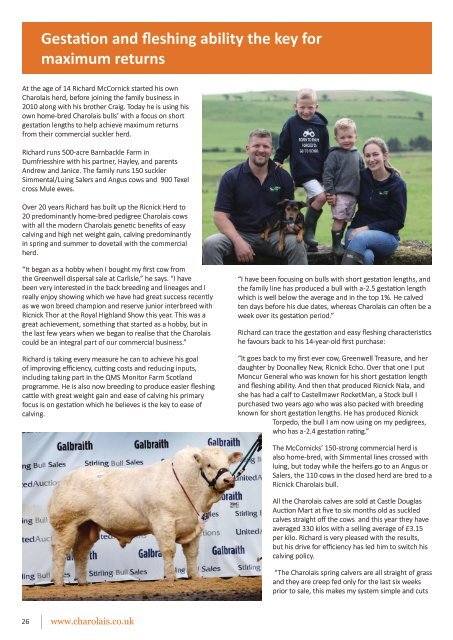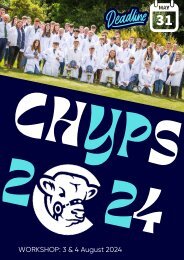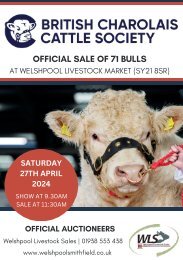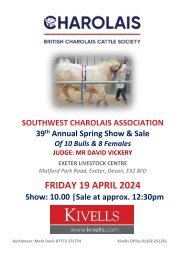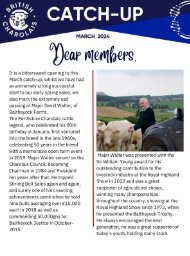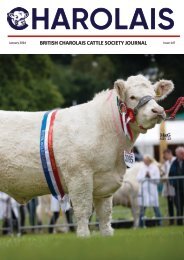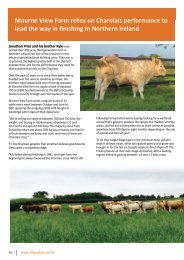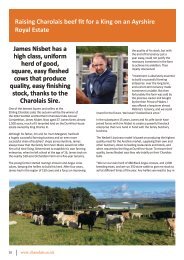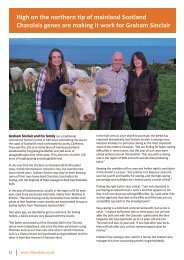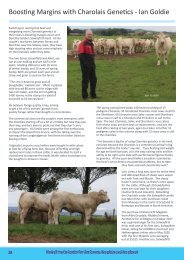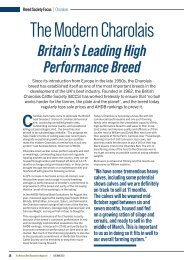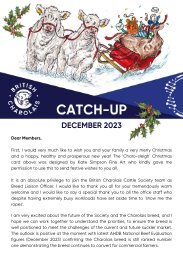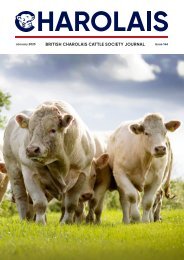Create successful ePaper yourself
Turn your PDF publications into a flip-book with our unique Google optimized e-Paper software.
Gestation and fleshing ability the key for<br />
maximum returns<br />
At the age of 14 Richard McCornick started <strong>his</strong> own<br />
<strong>Charolais</strong> herd, before joining the family business in<br />
2010 along with <strong>his</strong> brother Craig. Today he is using <strong>his</strong><br />
own home-<strong>bred</strong> <strong>Charolais</strong> bulls’ with a focus on short<br />
gestation lengths to help achieve maximum returns<br />
from their commercial suckler herd.<br />
Richard runs 500-acre Barnbackle Farm in<br />
Dumfriesshire with <strong>his</strong> partner, Hayley, and p<strong>are</strong>nts<br />
Andrew and Janice. The family runs 150 suckler<br />
Simmental/Luing Salers and Angus cows and 900 Texel<br />
cross Mule ewes.<br />
Over 20 years Richard has built up the Ricnick Herd to<br />
20 predominantly home-<strong>bred</strong> pedigree <strong>Charolais</strong> cows<br />
with all the modern <strong>Charolais</strong> genetic benefits of easy<br />
calving and high net weight gain, calving predominantly<br />
in spring and summer to dovetail with the commercial<br />
herd.<br />
“It began as a hobby when I bought my first cow from<br />
the Greenwell dispersal sale at Carlisle,” he says. “I have<br />
been very interested in the back breeding and lineages and I<br />
really enjoy showing which we have had great success recently<br />
as we won breed champion and reserve junior interbreed with<br />
Ricnick Thor at the Royal Highland Show t<strong>his</strong> year. T<strong>his</strong> was a<br />
great achievement, something that started as a hobby, but in<br />
the last few years when we began to realise that the <strong>Charolais</strong><br />
could be an integral part of our commercial business.”<br />
Richard is taking every measure he can to achieve <strong>his</strong> goal<br />
of improving efficiency, cutting costs and reducing inputs,<br />
including taking part in the QMS Monitor Farm Scotland<br />
programme. He is also now breeding to produce easier fleshing<br />
<strong>cattle</strong> with great weight gain and ease of calving <strong>his</strong> primary<br />
focus is on gestation which he believes is the key to ease of<br />
calving.<br />
“I have been focusing on bulls with short gestation lengths, and<br />
the family line has produced a bull with a -2.5 gestation length<br />
which is well below the average and in the top 1%. He calved<br />
ten days before <strong>his</strong> due dates, whereas <strong>Charolais</strong> can often be a<br />
week over its gestation period.”<br />
Richard can trace the gestation and easy fleshing characteristics<br />
he favours back to <strong>his</strong> 14-year-old first purchase:<br />
“It goes back to my first ever cow, Greenwell Treasure, and her<br />
daughter by Doonalley New, Ricnick Echo. Over that one I put<br />
Moncur General who was known for <strong>his</strong> short gestation length<br />
and fleshing ability. And then that produced Ricnick Nala, and<br />
she has had a calf to Castellmawr RocketMan, a Stock bull I<br />
purchased two years ago who was also packed with breeding<br />
known for short gestation lengths. He has produced Ricnick<br />
Torpedo, the bull I am now using on my pedigrees,<br />
who has a -2.4 gestation rating.”<br />
The McCornicks’ 150-strong commercial herd is<br />
also home-<strong>bred</strong>, with Simmental lines crossed with<br />
luing, but today while the heifers go to an Angus or<br />
Salers, the 110 cows in the closed herd <strong>are</strong> <strong>bred</strong> to a<br />
Ricnick <strong>Charolais</strong> bull.<br />
All the <strong>Charolais</strong> calves <strong>are</strong> sold at Castle Douglas<br />
Auction Mart at five to six months old as suckled<br />
calves straight off the cows and t<strong>his</strong> year they have<br />
averaged 330 kilos with a selling average of £3.15<br />
per kilo. Richard is very pleased with the results,<br />
but <strong>his</strong> drive for efficiency has led him to switch <strong>his</strong><br />
calving policy.<br />
“The <strong>Charolais</strong> spring calvers <strong>are</strong> all straight of grass<br />
and they <strong>are</strong> creep fed only for the last six weeks<br />
prior to sale, t<strong>his</strong> makes my system simple and cuts<br />
26<br />
www.charolais.co.uk
down on costs. The growth rates I get<br />
<strong>are</strong> excellent, with net gain between<br />
1.6 and 1.8 kilos per day from birth<br />
and I am very happy with t<strong>his</strong>.<br />
“Summer calvers overwinter<br />
November to April and <strong>are</strong> kept<br />
inside all the time, calves <strong>are</strong> also<br />
sold straight off the cows, but t<strong>his</strong> is<br />
obviously more expensive, so we <strong>are</strong><br />
planning moving closer to all spring<br />
calving.”<br />
The McCornicks <strong>are</strong> also finding<br />
significant efficiencies from wintering<br />
their cows outside.<br />
“The in calf commercial and pedigrees<br />
cows <strong>are</strong> outwintered from November<br />
to February and fed on Kale and<br />
haylage, which I believe makes them<br />
fit not fat – much fitter and more<br />
agile than if they have been inside<br />
all winter, and since we started t<strong>his</strong><br />
<strong>are</strong> <strong>producing</strong> <strong>cattle</strong> <strong>his</strong> <strong>target</strong> <strong>market</strong> <strong>likes</strong>, and adding another<br />
important dimension to <strong>his</strong> business.<br />
“We have a very good <strong>market</strong> for our <strong>cattle</strong> with many repeat<br />
buyers. Our buyers in the past have been predominantly from<br />
Aberdeenshire but we <strong>are</strong> now selling more and more to<br />
finishers from the North of England.<br />
“Bulls <strong>are</strong> sold both through the Stirling Bull sales where we<br />
have sold bulls to 16k on two occasions in the past year and<br />
direct from the farm, and it is great that more and more <strong>are</strong><br />
recognising the traits of the Ricnick herd with a lot of the<br />
<strong>Charolais</strong> <strong>cattle</strong> sold through Wallets Mart <strong>are</strong> off Ricnick bulls<br />
which is great to see. I am <strong>producing</strong> bulls for the commercial<br />
<strong>market</strong>s, bulls which I would like to use myself, and I am very<br />
pleased that the lines I began 20 years ago is now appealing<br />
both to the breeders and to the commercial producers.”<br />
regime, our calving intervention has been minimal”<br />
and with reduced costs from not being inside it’s a<br />
win win situation.<br />
The mainly summer calving <strong>Charolais</strong> herd was true<br />
to the British <strong>Charolais</strong>’ growing reputation for easy<br />
calving, but the results from the commercial herd<br />
were just as impressive.<br />
“T<strong>his</strong> year spring calving was the best scanning I<br />
have ever had: 108 cows were scanned, 108 were in<br />
calf and there were three sets of twins, so t<strong>his</strong> was<br />
a 103% calving which is amazing and with reduced<br />
bulling period was a great success and testament to<br />
the ease of calving and health of the cows.”<br />
Richard McCornick’s breeding and calving regimes<br />
<strong>are</strong> <strong>producing</strong> exactly the efficiencies he is seeking<br />
to make Barnbackle Farm as fit as <strong>his</strong> cows for a<br />
sustainable future. His home-<strong>bred</strong> <strong>Charolais</strong> <strong>genetics</strong><br />
www.charolais.co.uk 27


